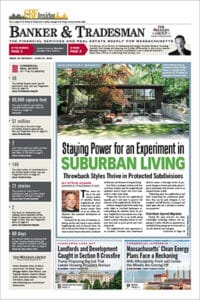
Jarred Johnson
Greater Boston has significantly boosted transit in its core over the past few decades. Assembly Row has flourished around the Orange Line, the Green Line Extension has spurred new development and housing continues to rise elsewhere near rapid transit.
But while transit in the core has strengthened, suburban transit has deteriorated – bus routes have been cut, shuttles defunded and last-mile connections ignored.
The result? Many suburban residents and workers are left with few transit options beyond driving.
Commuter rail ridership isn’t as strong as it could be because many stations remain difficult to access without a car. Meanwhile, towns and cities working to build transit-oriented housing developments are left without reliable transit connections.
The Business Case
Transit access is a major driver of real estate value. Developers and employers get it – transit access moves markets. A well-connected transit system means higher property values, more foot traffic for businesses and a stronger foundation for walkable communities.
But right now, too many suburban transit corridors are stuck in limbo – disconnected, underfunded, or barely running often enough to be helpful. That’s not just a transportation problem; it’s a missed economic opportunity.
Housing and commercial development in the suburbs is happening – but without adequate transit, these projects face an uphill battle. Places like Lynn, Brockton and Watertown are seeing new housing growth, yet suburban transit service isn’t keeping up, pushing more residents toward driving. The end result will be even more traffic.
This isn’t just a transportation issue – it’s an economic issue. Employers along Route 128 and job centers like Waltham can struggle to attract workers due to unreliable transit. A stronger suburban transit network would open up more job opportunities, reduce commuting costs and make suburban communities more attractive places to live and work.
Cutting suburban transit isn’t just bad for those who rely on it – it weakens suburban real estate markets, discourages businesses from expanding and makes transit-oriented development less viable. If Greater Boston is serious about reducing congestion, supporting smart growth and maintaining a competitive real estate market, it must prioritize suburban transit.
Suburban Transit is Working Across North America
Greater Boston isn’t the only metro area facing these challenges – but other cities are solving them.
Toronto has aggressively expanded suburban transit alongside upgrades to its GO Transit commuter rail network. This investment has helped foster high-density, transit-oriented housing in places like Brampton and Mississauga, allowing suburban transit ridership to grow. Brampton, once a car-dependent city, now boasts some of North America’s highest per-capita transit ridership thanks to targeted investment in bus rapid transit and frequent suburban bus service.
In Los Angeles, the Metro G Line BRT has catalyzed residential and commercial growth in the San Fernando Valley, transforming Warner Center – 22 miles from downtown – into a major transit-oriented district.
In the U.S., cities like Seattle and Minneapolis have also demonstrated how robust suburban transit investment leads to economic growth. Seattle’s RapidRide bus network has driven new development in previously car-dependent areas. At the same time, the Twin Cities’ A Line BRT has brought mixed-use development to suburban transit corridors.
These cities prove that suburban transit investment isn’t just about mobility – it’s about shaping growth, reducing congestion and strengthening real estate markets.
Essential for the Future of Commuter Rail
The MBTA has big plans to improve its commuter rail system. Still, faster trains and better schedules won’t be successful if stations remain challenging to reach. A strong suburban transit network is essential to ensuring that commuter rail becomes a reliable alternative to driving, not just a last resort.
Parking shortages at suburban commuter rail stations are a growing problem. Without reliable bus or microtransit connections, most riders are forced to drive to stations. But parking alone isn’t the solution – many stations have limited space, and expanding parking lots is costly and inefficient.
Instead, investing in suburban bus networks, microtransit and multimodal connections would allow more people to reach commuter rail without needing a car. This would boost commuter rail ridership, reduce reliance on expensive parking and make transit more competitive with driving.
Commuter rail expansion without suburban transit investment is an incomplete strategy. If Massachusetts is serious about modernizing its rail system, it must ensure that suburban transit is part of the equation alongside new electric trains.
What Needs to Happen
Suburban transit isn’t just about getting people to work – it’s about ensuring smart growth, supporting local economies and making Greater Boston more livable. But right now, it is treated as an afterthought.
To change this, the state and the MBTA must prioritize suburban transit alongside core investments. Expanding suburban bus routes, streamlining shuttle services and supporting microtransit will make commuter rail more accessible. But coordination isn’t just about better planning – it requires real investment to ensure that lower-frequency services can reliably connect with more frequent ones.
Developers and business leaders must be vocal advocates for suburban transit expansion. The CRE industry is uniquely positioned to push for transit investments that support sustainable, long-term growth. Without strong suburban transit, new developments will house fewer people and reinforce auto-oriented development patterns, limiting Greater Boston’s ability to grow sustainably and support a stronger regional economy.
The time to act is now. Stronger transit makes for stronger development – and a stronger region.
Jarred Johnson is the former executive director of advocacy organization TransitMatters.






